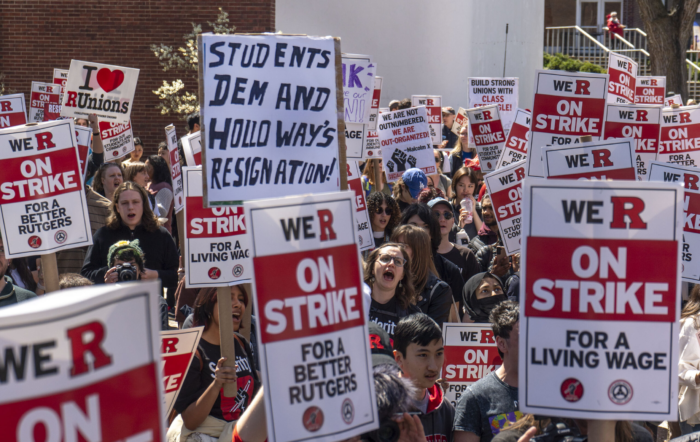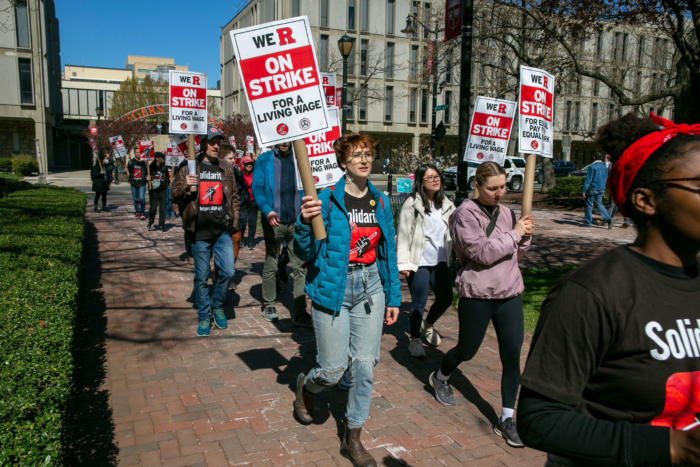Republished from Black Rose Anarchist Federation
In April 2023, faculty and graduate student workers at Rutgers University staged an historic five day strike. The strike was mostly over wages and working conditions, and contributed to a recent wave of labor actions at institutions of higher education in the United States. While they did not win everything, the strike led to serious gains for some workers, including a 40% pay increase for adjuncts and 30% pay increase for graduate student workers.
Although most left and labor media representation of the strike was celebratory, the real history and impact of the strike is more complicated. Not every worker won big gains in the strike, and its resolution was not made on the most democratic of grounds. To get a fuller picture we turned to rank-and-file PTFLC-AAUP-AFT member and Black Rose/Rosa Negra militant Clarence O’Dell. An adjunct faculty member, O’Dell says that the strike is mostly a huge victory, and something to celebrate. However, he says that our movements need to learn from the mistakes and missteps too. These include a strike process that was more leadership driven rather than membership driven, and a settlement that ultimately left out some academic workers on campus.
Black Rose / Rosa Negra (BRRN): Can you briefly talk about your position at the university? What union are you affiliated with?
Clarence O’Dell (CO): I am an adjunct instructor at Rutgers, which means I am a part of a precarious workforce that does the bulk of the teaching on campus. Universities have used “adjuncts” in increasing numbers in the last two decades because they can pay us poverty wages, don’t have to provide benefits like health care, and we can simply not be hired if demand for classes is low. I am a rank and file member of the part time faculty union, a local of the American Association of University Professors – American Federation of Teachers (PTLFC-AAUP-AFT).
BRRN: What did the leadup to the strike look like? What were the official demands put forward by the union? Did these line up with the demands of rank-and-file workers? What unions were involved and who do they represent?
CO: There are three major unions on campus: one for the grad students, full time faculty and counselors (AAUP-AFT), one for the adjuncts (PTLFC-AAUP-AFT), and one for university staff (URA-AFT 1766). The strike was a long time coming – it’s been years in the making. The short version is that Rutgers has the longest standing faculty union in the US, dating back to the 1970s. In the last several faculty contracts, the results were less than stellar, and a minority faction in the adjunct union organized a “no” vote for the last contract. They recognized that the university was not going to give up the wage increases, health care coverage, and other big gains for workers on campus without a credible strike threat. So this faction first ran a “no” campaign, and then ran for officer positions which they mostly won. It was this leadership that began transforming the union from a traditional business union model, to a strike ready fighting union. They hired an organizer to do membership development. They got the contracts to line up such that they would expire all at the same time. They hosted “strike schools” and “freedom schools” to build labor militancy in the union. They did a lot of ground work to make this happen.
With this strike, the union had been negotiating for this contract for a full year, and the university had stalled and delayed and refused to meet many of the demands well past the expiration of the last contract. There were some big demands. The biggest was “equal pay for equal work” which was designed to mitigate using low wage workers on a short term contract. Over the last three decades the industry standard has emerged for “two-tier” faculty hiring. There is a top tier of faculty who have tenure, a kind of job protection, benefits, decent pay, etc. And there is a lower tier, adjuncts, who have none of those benefits and are paid a fraction of what tenured faculty make. A key demand of this round of contract negotiating was to have adjunct workers receive equal pay to a full timer for the portion of courses that we teach. If achieved, this demand would go a long way to ending the incentive held by the university to hire adjuncts. If adjuncts and tenure track were an equal cost, it might lead to the creation of more full time jobs.
But ‘equal pay for equal work’ was not the only demand. The unions representing graduate students, faculty, and adjuncts were asking for raises to keep up with inflation, a living wage for graduate workers, and job security with presumptive rehiring for all faculty. In addition, the unions were demanding “common good” and racial equity demands that included DEI initiatives, housing justice with affordable rents in and around campus, and other demands. These were broadly popular, and did seem to speak to the major needs of members and students.

BRRN: There has been a great amount of discussion and celebration of the “wall-to-wall” or “industrial” model of unionism at Rutgers. Can you briefly describe the theory and some of the history behind this model?
CO: The industrial model of union organizing is about maximizing worker power. The basic idea is that if all the workers in a workplace withhold their labor at once, the boss will be powerless to stop them and will have to give in to their demands if they want to keep the workplace functioning and money rolling in. This is in distinction to the “craft” model of organizing, in which just a segment of the workforce is unionized, usually based on a shared job type, skill, or craft, and they bargain and strike and organize independent of the other workers.
The industrial model was very popular with radicals, in fact the famous Wobblies, the Industrial Workers of the World (IWW) used this very model built around the slogan, “One Big Union” for all workers. Not only was this a strategy to maximize labor power, but it was an attempt to overcome the racial, ethnic, and gender divisions in a workplace. Instead of racial hostilities dividing workers, the industrial model could bring people together, demonstrate our shared interests, and our collective power.
At Rutgers, the major campus unions have been moving toward an industrial model for some time. The grad students and the full time faculty are already in a union together, but the hope was to bring adjuncts and staff all into the same unit. They asked the university to voluntarily recognize a single unit, which the school declined, and because of the laws in the state of New Jersey it is unlikely that the Rutgers unions will reach industrial status.
Nonetheless, the unions bargained, negotiated, and struck in unison, as if they were a single union. There was a high degree of coordination across the unions, especially at the leadership level, and this led to the first strike of all the instructor academic positions on campus in the university’s history.
BRRN: Given that, as you said, this strike was the first by academic workers in the university’s 253 year history, this was also the first time that the wall-to-wall model you described has been put to the test. How did it function when the rubber met the road?
CO: As good as the industrial model is, there are also some problems with it. The first, is that not all the campus workers went out on strike together this time around. The union representing staff said they felt pressured to strike with faculty and refused to go out at the same time. This seemed to be coming from their more conservative leadership, who are more business minded and simply did not want to strike. This was unfortunate because, had they worked in concert with the academic unions, it would have been a true campus wide, all worker strike, which could have been really powerful. Instead, the staff union is still negotiating their contract and it seems that they are not getting very far alone.
There was another problem with industrial model as it played out at Rutgers; and this is that not every segment of the union won significant gains. For example, the unit I’m in, adjuncts, and the graduate students, both won really impressive raises, as much as 40% for some workers. This is huge and definitely needs to be celebrated. But this came at the expense of other workers who did not see big gains. For example full time faculty are getting 3 or 4 percent wages increase per year for the next four years. This does not even come close to the rate of inflation for this last year, so they are in effect taking a pay cut. Other workers, the medical faculty, got almost none of their demands met, the biggest of which was for paid parental leave and longer term contracts. So in this industrial model while some workers won big, other units of workers had to take sacrifices to achieve that.
But I think there was a bigger problem with how the strike played out, and this was a lack of democratic practice, especially as the strike drew to a close. Instead of checking with members and making sure that they were informed and empowered to decide whether and how to end the strike, the union leadership unilaterally decided to suspend the strike and approve the tentative framework for a union wide vote. The townhall meetings that they held were carefully managed and did not allow for discussion before they already made these decisions. There is a good Labor Notes article that spells out their thinking. But it meant that many of these workers who did not get much from this contract did not have a way to talk about or strategize what could be done in these circumstances.

BRRN: Do you think these problems were a result of deficiencies in the model itself?
CO: I’m not sure if these are problems inherent in the model. It does seem with more democratic processes in union these shortfalls could be overcome. But they did engender some hard feelings in the unions, mostly from graduate students, actually. They felt that the closure of the strike was not democratic, and that the union leadership did not take their concerns seriously. They had some really vitriolic personal criticism of the leadership, which I think crossed the line and went too far in some cases. But the basis of their critique was correct. It should be the members should decide when and how to end a strike, and moreover, that we need structures of democratic decision making in the union to make sure that we are all moving along together and that no one gets left behind. These are problems that can be overcome with better organizing practice I think.
BRRN: What key lesson(s) should other university workers take from the Rutgers strike?
CO: When we strike, we win. Truly. It is only through organized labor power that working people can win anything in this society. And in higher ed we won big wage gains for the most exploited in our ranks, the adjuncts and graduate students. But more than this, we need to be critical of our own practice. We need to learn to fight better and to win more. These wage gains are great. But ultimately, wage gains on a dying planet isn’t going to do much for us. We need to overthrow this system, and the only way we can do that is by building our collective power in organizations like unions. Lets build better fighting organizations for the working class, and learn to fight better, and fight for more, and fight to win. This strike was one step in that direction.